Bhog, offering an elaborate lunch to the deities, is an integral part of the puja rituals. The menu is almost the same for all the Autumnal Goddesses. Sarika shares a complete Bhog platter – savoury, sweet, delicious, and elaborate – in an exclusive Special Feature for Different Truths.
The time of the year when the bright blue sky is shining with a gentle breeze, and the leftover clouds are hovering around and meeting each other mainly over the open fields. It is autumn, and for Bengalis, it is the beloved Shorotkal (Autumn season).
Shamiana-covered Pujo bari is a favourite sight for Bengalis around the world. Kids play around aimlessly. However, kids are a little more focused these days, and their fun ways are probably a little different than ours. Beautiful ladies rush by wearing handloom saree and jewellery. Men are busy managing other logistic challenges and coordination (mostly)
The most amazing part is the announcement – sobai bose porun, ekhoni khichuri deya hobe – expectant eaters sit down to enjoy melting khichuri, molten chutney, labra mixed vegetables, and sweets.
The Bhog is very simple yet mouth-watering. Bhog is the blessed food of the Durga and other pujas. Typically, by rows of people seated on the puja bari floor, managed by the volunteers. Holding a large bucket of steaming Khichuri- Screaming- Bolo Durga Mai ki joi- The beats of dhak and the sound of shankh (conch) fill the surroundings of pandals with a positive essence of spirituality.
Anyone and everyone can join puja and Bhog. The gastronomical feast that has been an essential part of the Bengali culture is also visible during Durga puja Bhog. A decadent platter of some authentic Bengali dishes is offered to the deity.
Here I am sharing a few vegetarian recipes we mainly offer to Maa Durga – Lokhi (Lakshmi), Kali and Jagadatri – as Bhog.
Khichuri, accompanied by labra (a kind of mixed seasonal vegetable stew), aubergine fried, and chutney, is mainly served to the deities.
Mostly Bengalis are hard-core non-vegetarians, but a few classic vegetarian dishes which Bengalis adorn wholeheartedly.
Khichuri Platter
1. Choler Dal
Ingredients
- · 1 cup chana dal (split and husked Bengal gram)
- · 2.5 cups of water for pressure cooking and around five cups of water for cooking in a pot/kadhai
- · One tbsp raisins
- · One tbsp cashews
- · Two tsp sugar
- · ½ tsp turmeric powder
- · Two tsp sugar (or as required)
- · ½ tsp cumin powder
- · ½ tsp chilli powder (or as required)
- · ½ tsp cumin seeds
For Tempering
- · 1 medium tej patta (Indian bay leaf)
- · Two to three dried red chillies (preferably broken and seeds removed)
- · One pinch asafoetida
- · Two tablespoons chopped coconut or two tablespoons fresh grated coconut
- · One teaspoon grated ginger or finely chopped ginger
For Spice Powder
- · A one-inch cinnamon
- · Three Clove
- · Two green cardamoms
Preparation
- Pick and rinse the dal well.
- Soak the dal for an hour in water.
- Meanwhile, take an inch of cinnamon, two green cardamoms and two to three cloves.
- Crush the whole spices in a mortar pestle until they are powdered. Place the spice powder aside.
- If you want to reduce the soaking time of dal, heat water and soak the dal in hot water for 30 minutes. Drain the water.
Making Cholar Dal
- 1. Once the dal is soaked, then drain all the water. Add the soaked chana dal and turmeric powder to the pressure cooker.
- 2. Next, add water.
- 3. On medium to high heat pressure, cook the dal for four to five whistles.
- 4. The grains should be separate but cooked thoroughly.
- 5. Once the pressure settles down naturally, then remove the lid
- 6. Add sugar and salt to the dal. If using raisins, then add them now.
- 7. Stir and keep the cooker on low heat to simmer the dal until the water reduces.
- 8. When you add the tempering to the dal, it should have the right consistency – meaning it should be slightly thick.
- 9. Remember that on cooling, the dal will become thicker.
- 10. While the dal is simmering and beginning to thicken, prepare the tempering.
Tempering Cholar Dal
- a. Heat 1 tbsp ghee or oil in a pan. First, add the following spices – 1 bay leaf (tej patta) and ½ teaspoon of cumin seeds.
- b. Next, add one tsp of grated ginger. Also, add 2 to 3 dried red chillies, one pinch of asafoetida (hing), and powdered whole spices.
- c. Fry till they become fragrant. This takes a few seconds. Then pour this tempering into the dal. Mix well.
- d. Stir and then add cumin powder and red chilli powder. Mix well.
Simmer the dal for 1 to 2 minutes more. Switch off the heat. Cover with a lid and set aside. - e. In the same pan, take one tablespoon of ghee or oil. Add two tablespoons of chopped or grated coconut. Fry till the coconut becomes light brown.
- f. Add the fried coconut and ghee or oil to the dal. Mix well.
- g. Serve Cholar Dal with luchi, koraishutir (green peas), kachori and even steamed rice if you prefer.
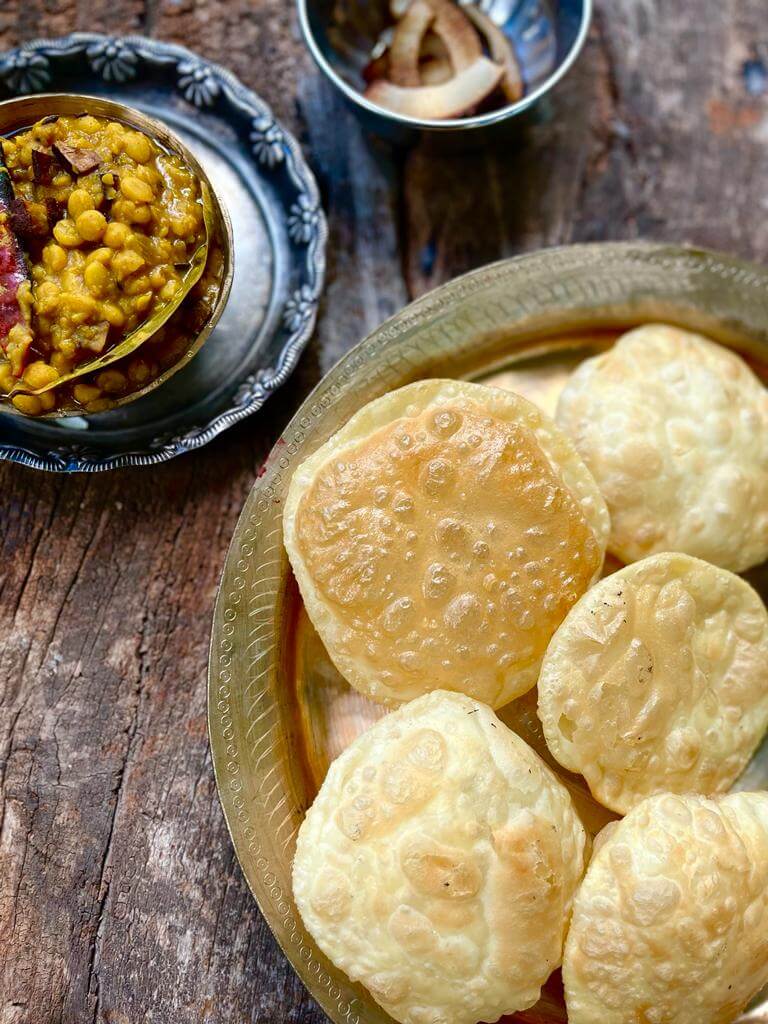
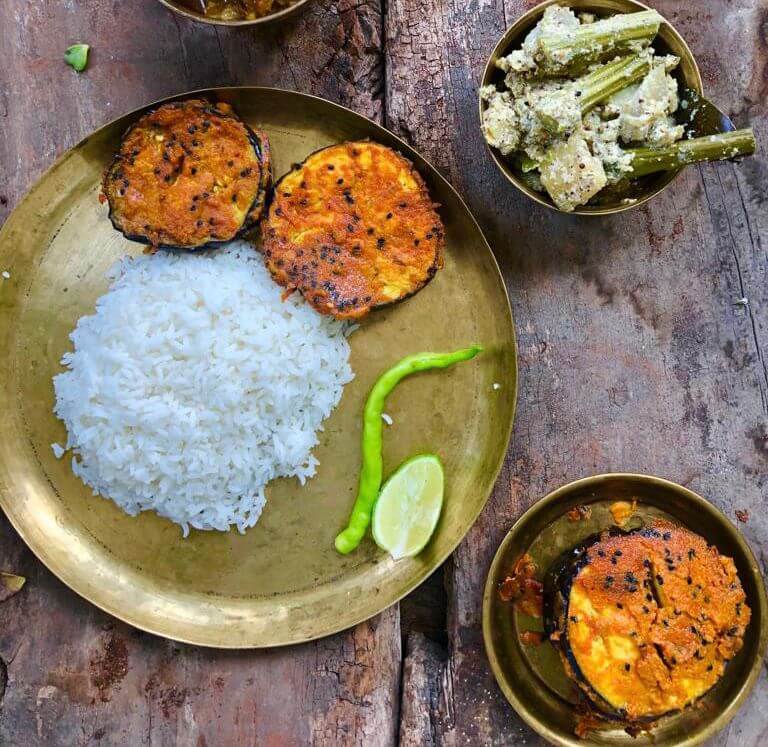
2. Luchi
Ingredients
- · All-purpose flour: 2 cups
- · Warm water: ¼th -1/3rd cup
- · Salt: ½ tsp
- · Oil or ghee: 1 tsp + 2 cups for deep frying
Method
- 1. Knead the dough with flour, salt, ghee and water.
- 2. Now pinch small balls out of dough and roll them into a circular disc using a rolling pin.
- 3. Deep fry in hot oil/ghee until puffed up.
- 4. Preferably drain on paper towels to discard excess oil.
Notes:
- a. Moyan (adding fat into flour) plays a vital role in kneading dough for luchi. It will ensure soft dough.
- b. Always allow the covered dough to rest for enough time.
- c. If there are any cracks on the surface of the luchi when added to the oil, it will turn into all oil-soaked hard flatbread, more like papad.
- d. You must take out the luchi from the oil at the correct time. Otherwise, luchi will be crisp (khoro), not soft. Some also like crispy luchis too.
3. Begun Bhaja
Ingredients
- 1 Eggplant aka Begun or Baingan
- One teaspoon of Turmeric powder
- ¾ teaspoon Salt
- One teaspoon Sugar
- 1 tbsp rice flour
- ¼ cup Mustard oil to fry the eggplant pieces
Method
- 1. Cut an eggplant or brinjal into round pieces of 1 cm. Make sure to cut the slices evenly with the same thickness. Wash the slices and keep them on a separate plate.
- 2. Add ¾ teaspoon salt, one teaspoon sugar, one teaspoon turmeric powder, and one teaspoon wheat flour into the bowl. Mix all the ingredients nicely.
- 3. Pour the mixture over the eggplant slices. Coat each piece evenly with the mixture and keep it aside for at least 10 minutes. The marination will release moisture and helps the eggplant pieces to absorb taste and flavour.
- 4. Put a pan on flame and allow it to become completely dry. Add ¼ cup mustard oil and put the flame on high until the oil becomes hot and smoke comes out.
- 5. Turn the flame to low and add the marinated eggplant slices into the pan.
- 6. Don’t overcrowd the pan. Fry them over medium flame for 3-4 minutes till golden brown patches occur.
- 7. Turn each piece with a turner and fry the other side similarly. Don’t fry these over a high flame, or these won’t get cooked from the centre.
Note: You may flip the pieces once or twice when frying for even cooking.
Strain the begun bhaja to remove excess oil and transfer them on a separate plate.
4. Chaler Payesh
Ingredients
- · Three tablespoons of Gobindobhog rice (or any other sticky short-grain rice.)
- · Two teaspoons of ghee (Optional)
- · 1-litre whole milk (full-fat milk)
- · ¼ cup sugar (or to taste)
- · ½ teaspoon cardamom powder
- · 10/12 chopped cashew nuts
- · 10/12 slivered pistachios
- · 10/12 slivered almonds
Method
- 1. Rinse the rice with water and soak it in ½ cup for 15-20 minutes.
- 2. Drain the water and mix the rice with ghee. Set aside.
- 3. Heat milk in a heavy bottom pan over medium-high heat and bring it to a boil. Stir very frequently to avoid scorching at the bottom of the pan.
- 4. Once the milk comes to a boil, reduce the heat to low.
- 5. Add the rice to the pan and cook until the rice is nicely cooked and the payesh has thickened (35-40 minutes). Stir frequently while cooking.
- 6. Add sugar and cook for another 3-4 minutes.
- 7. Add cardamom powder and mix well.
- 8. Check for sugar and add more if needed.
- 9. Garnish the payesh with cashew nuts, pistachios, and almonds. I also like to use some dried rose petals for a pop of colour.
- 10. Serve hot or chill for a few hours before serving.
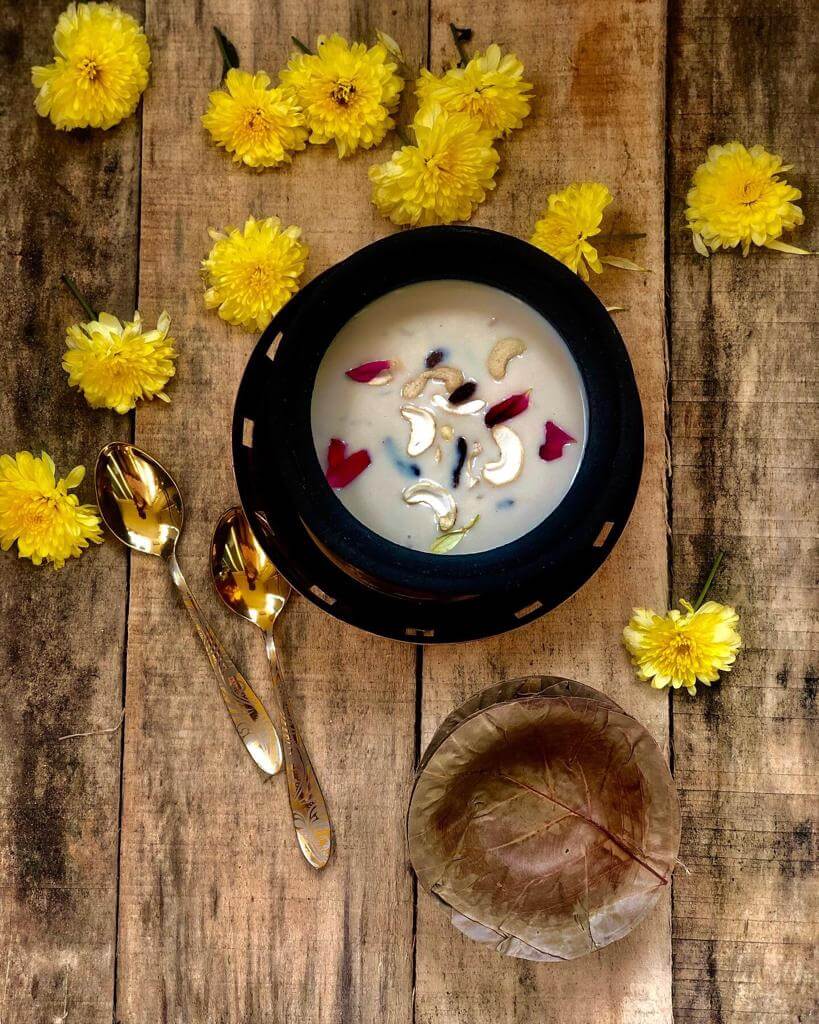
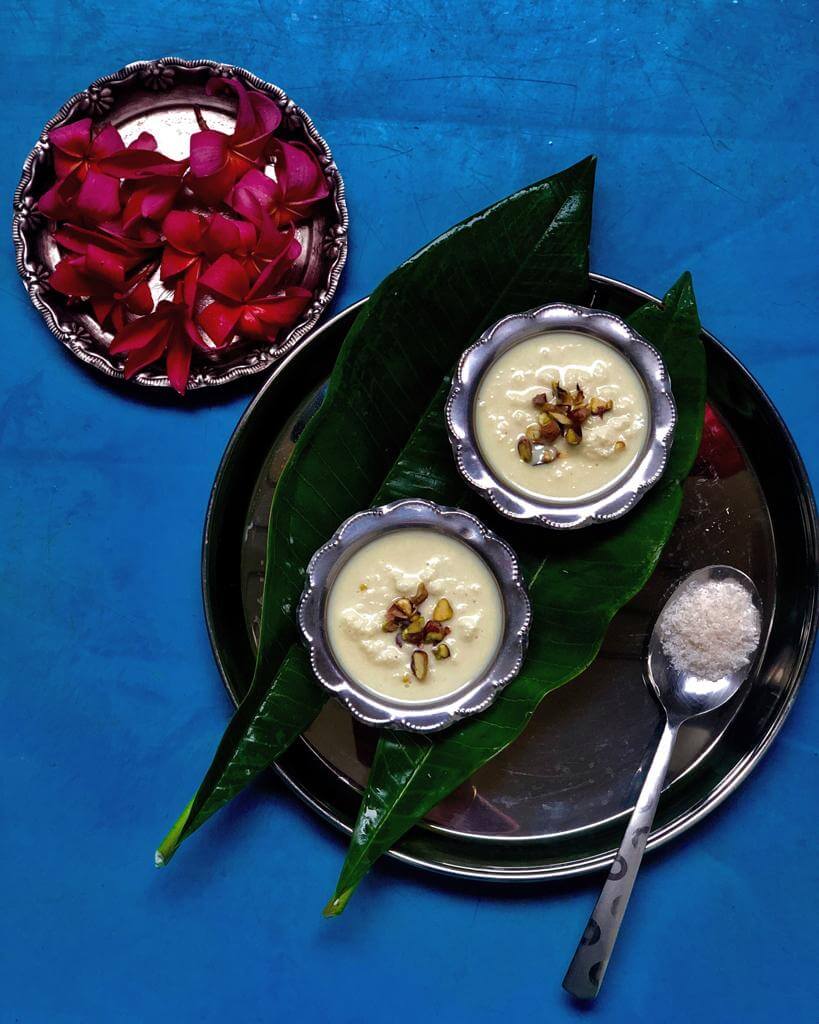
5. Narkel Er Payesh
Ingredients
- · 4 cups coconut freshly grated
- · 1lit whole milk
- · 200 ml thick coconut milk
- · ½ cup pistachios chopped
- · ½ tsp green cardamom powder
- · 1 tsp kewra water.
Method
- 1. Add the milk to a vessel and cook over the flame, occasionally stirring, till the milk almost reduces to one-third. Make sure it won’t stick to the bottom of the vessel.
- 2. Add the fresh coconut and keep stirring for ten more minutes over a low flame.
- 3. Add the cardamom powder and the pistachios.
- 4. Cook few more minutes; now add kewra water (it is optional)
- 5. Please turn off the stove and take the payesh off, allow it to settle down and finally garnish with pistachios (or any nuts available)
So that you know, you may add extra sugar here. I am okay with the additional natural sweetness of the coconut.
6. Chal Potol
Ingredients
- · 3/4 Gobindobhog rice (or you may use jeera rice)
- · 15 g cashew nuts
- · Eight potol (pointed gourd)
- · One tomato pureed
- · 2 tbsp raisins
- · 3 tbsp cooking oil (I used mustard oil)
- · 2 pcs dried red chillies
- · 2 pcs bay leaves
- · 2 pcs cardamom
- · Two pcs cloves
- · One pc cinnamon
- · ½ tbsp cumin seeds
- · ½ tbsp ginger paste
- · 1/2 tsp cumin powder
- · 1tspcoriander powder
- · 1 tsp turmeric
- · ¼ tsp red chilli powder
- · 3 tsp salt (according to taste)
- · 4 tsp sugar
- · 2 pcs green chillies
- · 2 tsp ghee
- · ¼ tsp garam masala
Method
- 1. Rinse the Gobindobhog rice, and spread it over a colander or a plate to air-dry completely,
- 2. Soak the raisins in water; keep them aside.
- 3. Wash and peel the potol into strips and halve each one. Now rub the potol halves with a bit of turmeric powder and salt.
- 4. Heat 1 tbsp in a frying pan and shallow fry them on medium-high heat until well browned. This should take 6 to 8 minutes. Drain from the oil and set it aside.
- 5. In the same pan, add ½ a tbsp. Ghee, when smoking hot, add crushed cinnamon, cloves and bay leaf wait till the spices release aroma. Add tomato puree and salt and cook until the raw smell of the tomatoes fades away.
- 6. Add ginger paste and coriander powder with water and set aside cumin powder, turmeric and red chilli powder.
- 7. Add the rice, turmeric powder, and sugar, and sauté for a few minutes.
- 8. Add in that fried potol and soaked raisins (drained from water)
- 9. Add warm water of around 1.5 cups over low flame until the rice is cooked. Add water if it looks very dry.
- 10. Finish with two slit green chillies for flavour, (optional) garam masala powder and a generous amount of ghee. Rest for eight to 10 minutes.
- 11. Ready to serve hot!
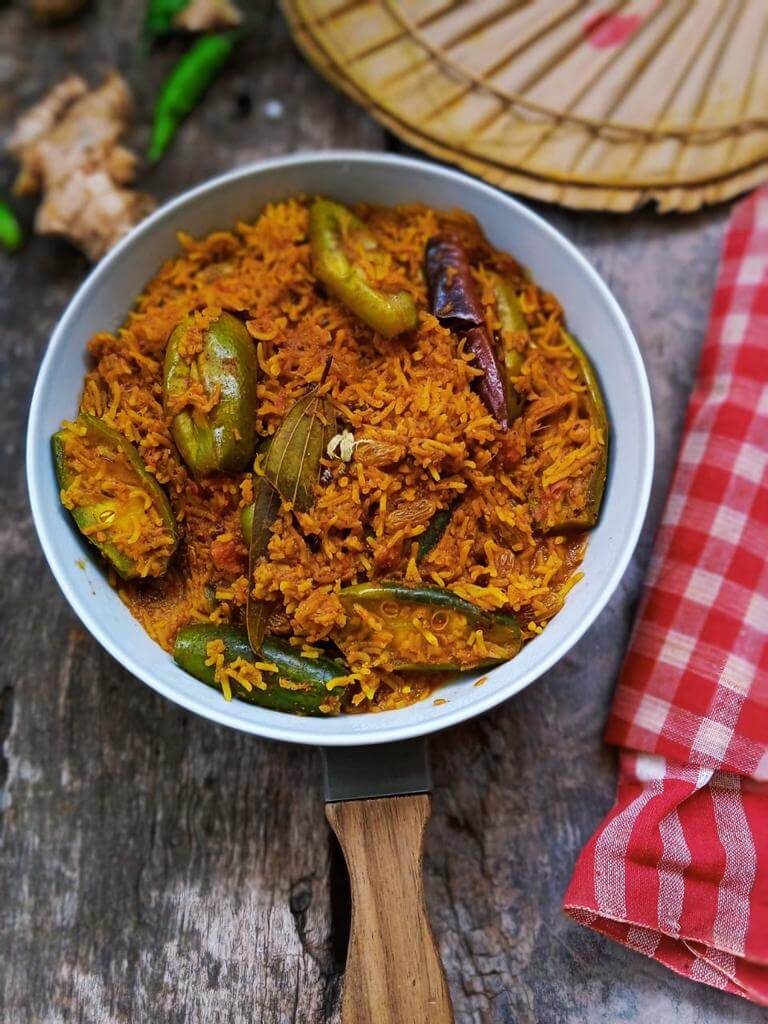
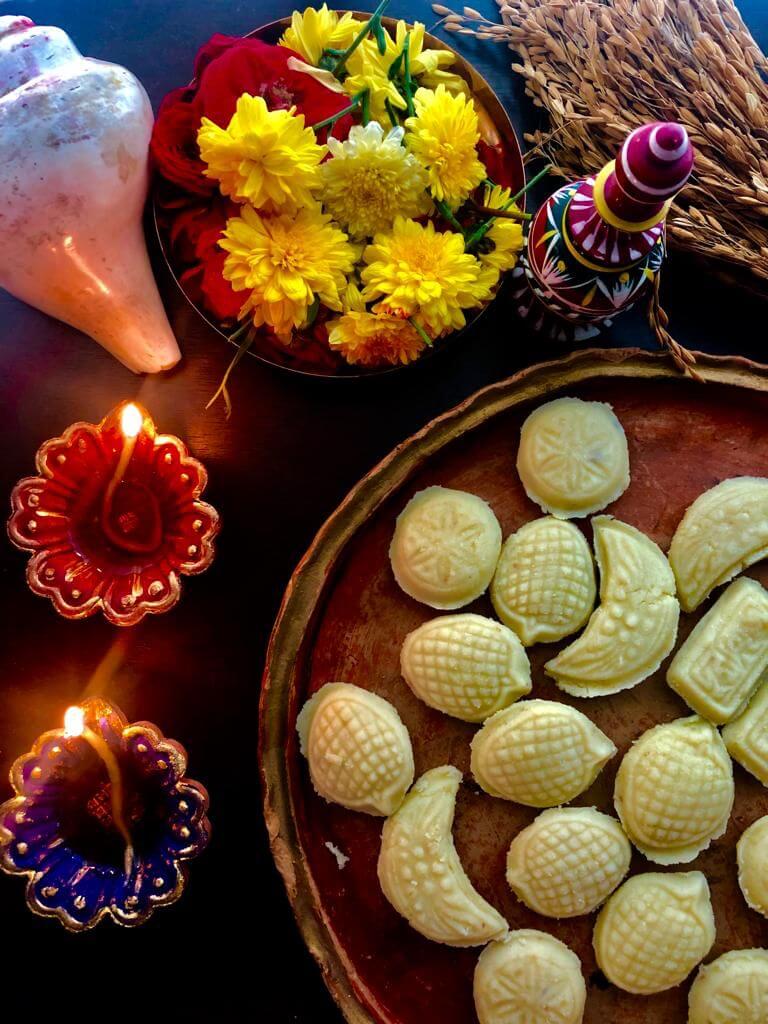
7. Kheer Sandesh
Ingredients
- 2 l Full Cream Milk
- one1 ¼ Cup Powdered Sugar
- ½ tsp Cardamom powder
- Melted ghee
- Sandesh moulds
Method
- 1. Bring the milk to a rolling boil in a heavy bottom pan.
- 2. keep simmering the milk on low heat till it reduces to one-third of its volume (it will take around two hours)
- 3. Keep stirring now and then. This step is crucial
- 4. Towards the final stage, add the powdered sugar in batches.
- 5. Keep mixing it properly.
- 6. Mix sugar evenly and adequately.
- 7. Sprinkle the cardamom powder and mix it nicely.
- 8. At this stage, the reduced milk should come out quickly.
- 9. Allow the reduced milk to cool till it feels warm to the touch. If it is too cold, it won’t set on moulds.
- 10. Grease the Sandesh moulds with the melted ghee.
- 11. Now divide the reduced milk into equal portions. Take one portion and gently press over the mould.
- 12. And very gently de-mould the Sandesh on a greased plate.
- 13. Once done, allow the Sandesh to rest for two to three hours at least.
- 14. Once done, place the kheer Sandesh at room temperature.
- Note:
- Tsp. teaspoon
- Tbsp. tablespoon
Photos by the author

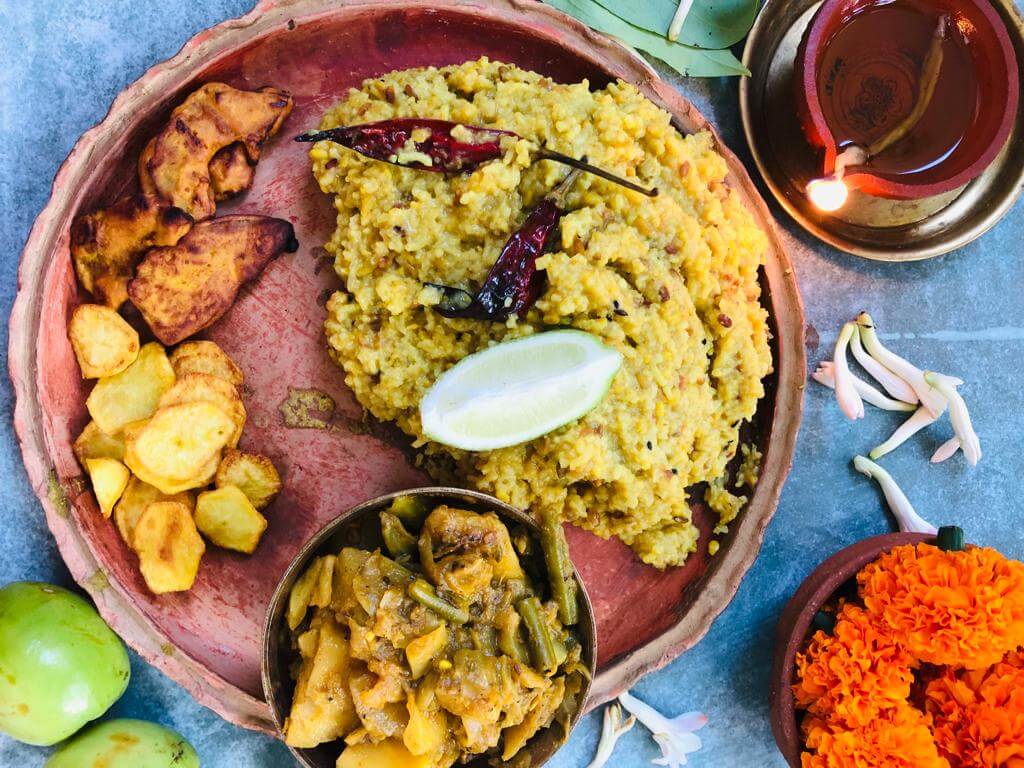

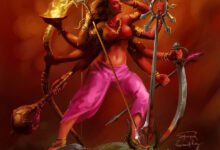

 By
By
 By
By
